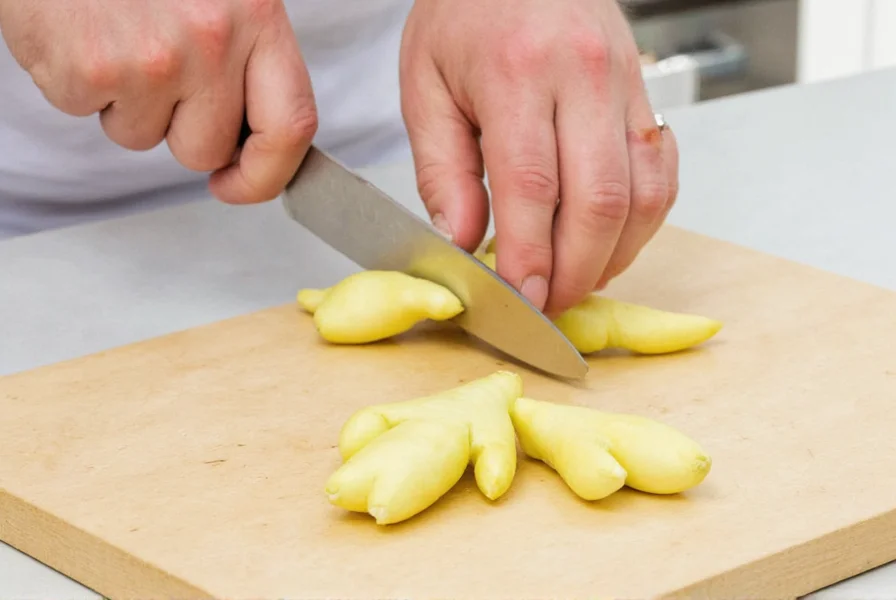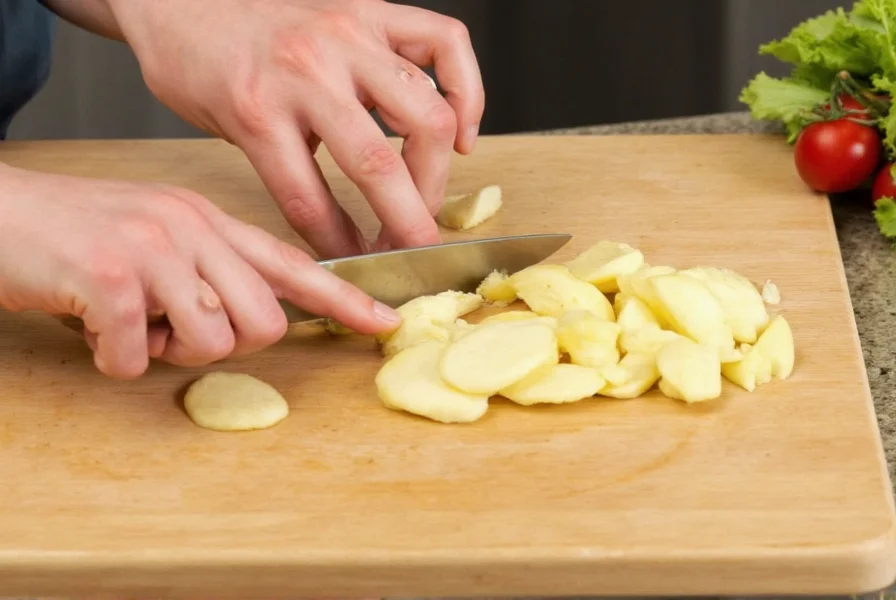Cutting ginger properly enhances flavor extraction and ensures optimal texture in your dishes. Whether you're preparing Asian cuisine, making ginger tea, or adding it to baked goods, the right cutting technique makes all the difference. This comprehensive guide covers professional methods that home cooks can easily implement with basic kitchen tools.
Essential Tools for Cutting Ginger
Before learning how to cut ginger, gather these kitchen essentials:
- Vegetable peeler or spoon - For removing the thin skin without wasting flesh
- Sharp chef's knife - An 8-inch blade provides control for precise cuts
- Cutting board - Preferably with grippers to prevent slipping
- Microplane grater - For creating fine ginger paste when needed
- Box grater - Alternative for coarser grating
| Tool | Best For | Alternative Options |
|---|---|---|
| Spoon | Peeling ginger root | Vegetable peeler |
| Chef's knife | Slicing and mincing | Paring knife |
| Microplane | Fine grating | Zester |
Step-by-Step Ginger Cutting Techniques
Peeling Ginger Properly
Unlike other root vegetables, ginger has a thin, papery skin that's easily removed without wasting precious flesh. The spoon method preserves more usable ginger than traditional peelers:
- Select firm ginger with smooth skin and no soft spots
- Hold a teaspoon by the handle and use the rounded edge
- Gently scrape along the ginger's surface, following its natural curves
- Work from top to bottom, rotating as needed
- Rinse briefly under cold water to remove any remaining fibers

Slicing Ginger for Cooking
Proper slicing technique maximizes flavor release while maintaining texture:
- Trim both ends of the ginger root with your knife
- Cut crosswise into 1/8-inch thick coins, working with the grain
- For stir-fries, stack coins and cut into matchsticks (julienne)
- For teas or infusions, leave as thin rounds
- For braises, cut slightly thicker (1/4-inch) to prevent overcooking
Mincing Ginger for Maximum Flavor
When recipes call for minced ginger, follow these professional steps:
- Slice ginger thinly across the grain
- Stack slices and cut lengthwise into thin strips
- Gather strips and rock your knife back and forth to create fine mince
- For extra fine mince, sprinkle with a pinch of salt to help break down fibers
- Use immediately for strongest flavor or store properly for later use
Advanced Ginger Preparation Methods
Grating Ginger Without Fibers
Grated ginger provides intense flavor but often contains unpleasant fibers. Use this professional technique:
- Freeze ginger for 20 minutes before grating for cleaner results
- Use a microplane held over a small bowl
- Grate using short, downward motions
- Stop when you reach the fibrous core
- For smooth sauces, strain grated ginger through cheesecloth
Cutting Ginger for Specific Dishes
Different culinary applications require specific ginger preparations:
- Stir-fries: Julienne (thin matchsticks) for even cooking
- Teas and infusions: Thin slices or crushed pieces
- Baking: Finely minced or microplaned for even distribution
- Ceviche: Ultra-fine mince to prevent overpowering delicate fish
- Marinades: Crushed then strained for pure flavor infusion
Pro Tips for Perfect Ginger Every Time
Professional chefs rely on these techniques when preparing ginger:
- Always cut against the grain to minimize stringiness
- Keep ginger refrigerated until ready to use for firmer texture
- Soak cut ginger in ice water for 10 minutes to crisp it up
- Use the side of your knife to crush ginger before mincing for better flavor release
- For stronger flavor, leave the skin on when making tea or stocks
- Store cut ginger in an airtight container with a paper towel to absorb moisture
Common Ginger Cutting Mistakes to Avoid
Avoid these frequent errors that compromise your ginger preparation:
- Using a dull knife that crushes rather than cuts the fibers
- Peeling too deeply and wasting usable ginger
- Cutting with the grain, creating stringy pieces
- Not removing the fibrous core when grating
- Preparing ginger too far in advance, causing flavor loss
- Using improper storage methods that lead to mold growth
Storing Cut Ginger Properly
Extend the freshness of your prepared ginger with these storage methods:
- Refrigerate in an airtight container with a paper towel for up to 1 week
- Submerge in dry sherry or vodka for up to 1 month (changes flavor slightly)
- Freeze minced ginger in ice cube trays with water for easy portioning
- Store whole unpeeled ginger in a paper bag in the vegetable drawer
- Never store cut ginger in plastic without moisture control
Frequently Asked Questions
Can you cut ginger without peeling it first?
Yes, you can use unpeeled ginger in certain applications. When making tea, stocks, or braises, simply scrub the ginger clean and slice it. The skin contains additional nutrients and flavor compounds. However, for dishes where appearance matters or when using raw ginger, peeling provides better texture and presentation.
What's the best way to cut large quantities of ginger efficiently?
For large batches, use this professional method: Peel the ginger with a spoon, then cut into 2-inch chunks. Slice these chunks into thin rounds, stack the rounds, and cut into matchsticks. Finally, gather the matchsticks and rock your knife to mince. This assembly-line approach maximizes efficiency while maintaining consistent results.
How do you prevent ginger from sticking to your knife?
To prevent ginger from sticking to your knife, lightly moisten the blade with water before cutting. Alternatively, rub a small amount of vegetable oil on the cutting surface of your knife. Professional chefs often use a ceramic knife for ginger as it naturally resists sticking. Keeping your knife extremely sharp also reduces sticking, as a clean cut separates fibers more effectively.
Why does my cut ginger turn gray or blue?
Some ginger varieties naturally contain anthocyanins, pigments that can turn bluish-gray when exposed to acids or during storage. This is completely normal and doesn't indicate spoilage. The color change occurs more frequently in young ginger and doesn't affect flavor or safety. Simply continue using the ginger as planned - the color will typically disappear during cooking.











 浙公网安备
33010002000092号
浙公网安备
33010002000092号 浙B2-20120091-4
浙B2-20120091-4